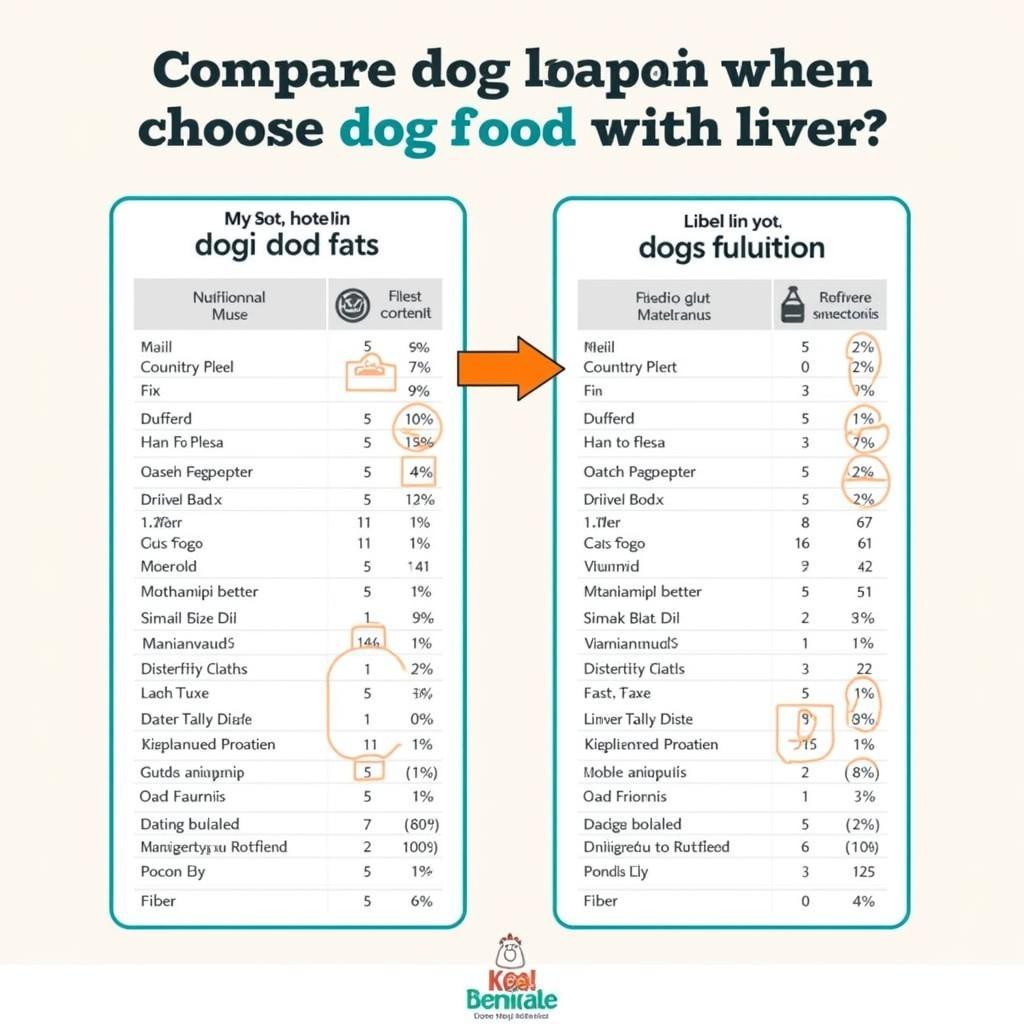Dog Food With Liver is a popular choice among pet owners, often touted for its palatability and nutritional benefits. But is it the right choice for your canine companion? This guide delves into the pros and cons of liver in dog food, helping you make an informed decision about your dog’s diet. We’ll explore everything from the nutritional value of liver to potential risks and considerations, ensuring you have all the information you need to choose the best dog food for your furry friend. You can find more resources on homemade dog diets, including those suitable for dogs with specific needs, like at homemade dog food for dogs with liver disease.
The Nutritional Powerhouse: Benefits of Liver in Dog Food
Liver is a nutrient-dense organ meat packed with vitamins and minerals essential for a dog’s health. It’s a rich source of vitamin A, crucial for vision, immune function, and cell growth. Liver also contains significant amounts of B vitamins, which support energy metabolism, nerve function, and red blood cell production. Furthermore, it provides iron, copper, and zinc, vital for healthy blood and a strong immune system.
Why is liver so appealing to dogs? The strong aroma and flavor of liver are naturally attractive to canines, making it an excellent palatability enhancer, especially for picky eaters. A small amount of liver can significantly boost the taste of dog food, encouraging even the fussiest dogs to eat their meals.
Potential Risks and Considerations of Dog Food with Liver
While liver offers numerous benefits, it’s crucial to understand the potential risks associated with excessive consumption. Too much vitamin A can lead to toxicity, causing bone problems, joint pain, and even liver damage. High levels of copper, although essential in moderation, can also accumulate in the liver and lead to health issues, especially in breeds predisposed to copper storage disease.
Is liver good for all dogs? While most dogs can safely consume liver in moderation, certain breeds may be more susceptible to complications. Dogs with pre-existing liver conditions should avoid excessive liver intake. Always consult with your veterinarian before introducing dog food with liver, especially if your dog has any underlying health concerns. They can help determine the appropriate amount of liver in your dog’s diet based on their individual needs and health status.
 Dog Enjoying Liver Kibble
Dog Enjoying Liver Kibble
Choosing the Right Dog Food with Liver
With the wide variety of dog foods available, selecting the right one can be overwhelming. Look for dog food where liver is listed as an ingredient, but not in excessive amounts. Check the guaranteed analysis for vitamin A and copper levels to ensure they are within safe limits. Prioritize high-quality brands that use human-grade ingredients and follow strict manufacturing processes. Finding a reputable brand often involves researching local suppliers or looking online, much like searching for ‘the pride dog food near me‘.
What about homemade dog food with liver? Preparing homemade dog food can be a rewarding way to ensure your dog receives a balanced and nutritious diet. However, formulating a complete and balanced diet requires careful planning and precise measurement of ingredients to avoid nutritional deficiencies or excesses. You can explore resources for creating balanced homemade meals, including options for dehydrated food sources at where can you buy dehydrated food.
How Much Liver is Too Much?
The appropriate amount of liver varies depending on the dog’s size, age, breed, and overall health. As a general guideline, liver should not exceed 5-10% of a dog’s total diet. For example, a small dog may only tolerate a few grams of liver per week, while a larger dog might handle a slightly larger amount. Always follow your veterinarian’s recommendations for the appropriate amount of liver in your dog’s diet. A balanced approach to canine nutrition includes choosing foods like canadai dog food that provide a comprehensive mix of nutrients, rather than relying solely on one ingredient like liver.
 Comparing Dog Food Labels
Comparing Dog Food Labels
Is Liver a Good Treat for Dogs?
Liver treats can be a healthy and appealing reward for dogs, but moderation is key. Offer liver treats sparingly to prevent overconsumption of vitamin A and copper. Opt for freeze-dried liver treats, which retain more nutrients than cooked liver. You can also find liver-flavored treats, which provide the enticing taste without the potential risks of consuming large amounts of liver. Looking for retailers who offer a variety of healthy dog treat options, similar to searching for ‘joy dog food retailers‘, can be a helpful strategy.
Conclusion
Dog food with liver can be a valuable addition to a dog’s diet, offering a wealth of essential nutrients and enhancing palatability. However, responsible feeding practices and moderation are crucial to avoid potential health risks associated with excessive liver consumption. By understanding the benefits and risks, and working closely with your veterinarian, you can make informed decisions about incorporating dog food with liver into your furry friend’s diet.
FAQ
- Can puppies eat dog food with liver?
- What are the signs of vitamin A toxicity in dogs?
- Are there any dog breeds that should completely avoid liver?
- What are some healthy alternatives to liver treats?
- Can I mix liver with my dog’s regular food?
- How can I tell if my dog is getting too much vitamin A?
- Are there any specific brands of dog food with liver that you recommend?
Scenarios where dog food with liver may be beneficial or not recommended.
- Beneficial: Picky eaters, dogs needing a nutritional boost, dogs with low iron levels (under veterinary supervision).
- Not Recommended: Dogs with pre-existing liver conditions, breeds prone to copper storage disease, dogs already consuming a high-vitamin A diet.
Further Reading
Explore more articles on dog nutrition and health on our website. Learn more about homemade diets and specific dietary needs.
For support, contact us 24/7: Phone: 02437655121, Email: [email protected] or visit us at 3PGH+8R9, ĐT70A, thôn Trung, Bắc Từ Liêm, Hà Nội, Việt Nam.